|
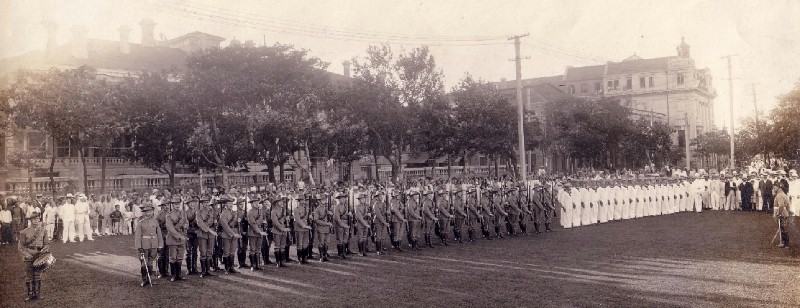
The German Prinz Heinrich Kompagnie of the SVC on
Parade with German Sailors
The Prinz Heinrich Kompagnie of the Shanghai Volunteer Corps are on the
left, the sailors on the right.
Photo © Rolf Weidlich

The German Prinz Heinrich Kompagnie of the SVC on
Parade
In this close up of the previous photograph we can see that the company are
wearing the khaki summer uniform with pockets and six buttons down the front of
the tunic. They wear the Australian slouch hat pinned up on the left hand side.
The other ranks carry
British British Lee
Metford Mk II rifles with British 1903 bandolier pouches. Note that
they stand at Present Arms in the manner of the Prussian army. The musician on the left with a Prussian
infantry drum and German style swallows nest insignia on his shoulders. It looks
like he also has an unidentified star insignia on his right cuff. The officer in
the centre of the photograph has a German officers belt and shoulder straps
displaying his rank.
Photo © Rolf Weidlich
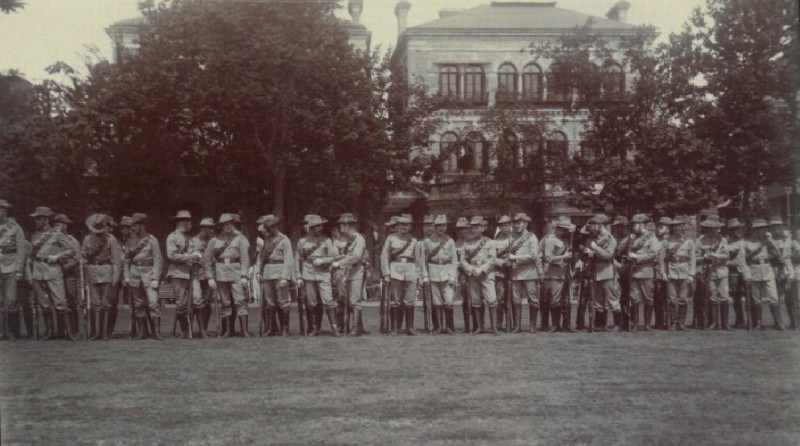
The German Prinz Heinrich Kompagnie of the SVC on Parade
They wear the pocketed khaki summer uniforms with Australian slouch hats.
The soldiers all carry British British Lee
Metford Mk II rifles with British 1903 bandolier pouches.
Photo © Mark Skurka see For
Sale Page
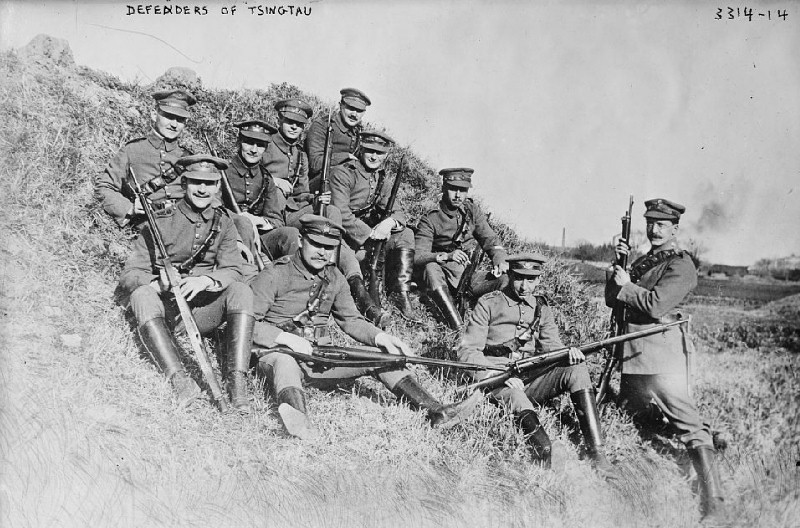
Volunteers from the German Prinz Heinrich Kompagnie of the SVC,
possibly at Tsingtao 1914
This photograph is captioned as showing the defenders of Tsingtao in 1914.
These may then be some of the volunteers who made it to the besieged city from
Shanghai. They wear peaked field caps with German cockades above the SVC badge.
Their uniforms are the eight buttoned winter uniforms with the crowned H
monogram of the Prinz Heinrich Kompagnie visible on the shoulder straps. They
carry British British Lee
Metford Mk II rifles with British 1903 bandolier pouches. See
SVC at Tsingtao Photo for close
up details of this photo.
Photo from the
Library of Congress Collection

German, Austro-Hungarian and Portuguese
Soldiers of the SVC, 1916
Soldiers of all three nationalities are seen alongside
each other along with cadets in the foreground and civilians to the right. The
photograph is dated 1916, the tensions between the nations do not show despite
the fact that war was declared between Germany
and Portugal on March 9th of that year.
Photo © Rolf Weidlich
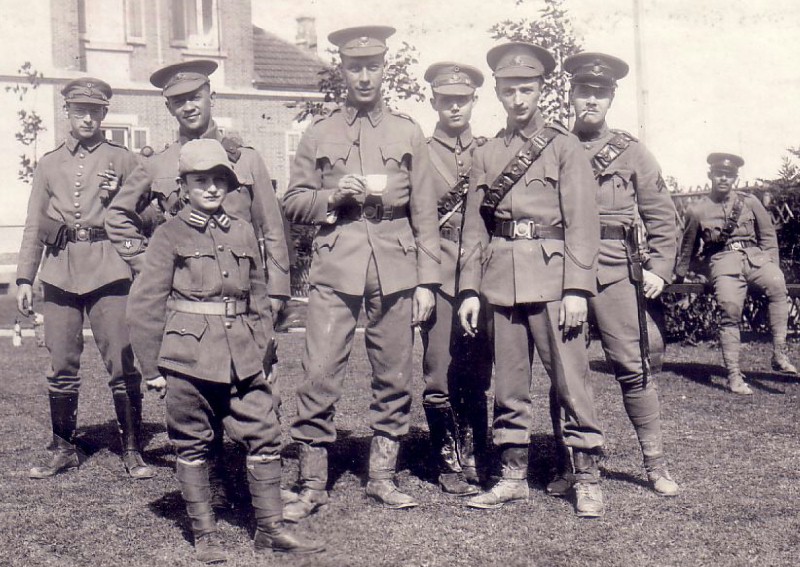
German, Austro-Hungarian and Portuguese
Soldiers of the SVC, 1916
All the soldiers wear the same peaked field caps with
the SVC badge, though the man on the far left has removed the wire holding the
crown in a stiff position from his cap. Judging from the shades of uniform thy may all have been locally made from
the same British dark khaki cloth in different cuts for each nation.
Soldiers of all three nationalities can be seen to wear the same belt and buckle
with British 1903 bandolier pouches.
The two German soldiers on the left and centre background can be identified by
their eight buttoned tunics and small imperial cockades above the SVC insignia on the front of their field
caps. The German on the far left has a different
style of ammunition or accessory pouch on his belt. It does not appear to be
German in origin.
The three Austro-Hungarian soldiers in the centre foreground wear similar
uniforms without the German cockade on their caps and with tunics in the Austrian
style, concealed fronts and three pointed scalloped pocket flaps over concealed
pockets. They have Austrian collar patches, with the centre figure having the
single rank star of a Gefreiter. The other two have a single five pointed
star on the right cuff- the significance of the this insignia is unknown (though
it might be the same as that shown on the photo of the German musician on parade above) The
gaiters of the Austrians are noticeably shorter than the Germans and of the
lighter shade. They may be the same type as used by the
Austro-Hungarian Navy in China.
The two soldiers from the
Portuguese company are on the far right. They wear similar peaked caps to the
Germans and Austrians, their tunics are of a similar shade and probably cut from
the same cloth but their breast pockets are pleated patch pockets with three
pointed flaps. The figure in the foreground has two upward pointing NCO rank
chevrons, both wear puttees with their ankle boots.
In the left foreground is a young
Cadet. with a floppy slouch hat. His tunic has collar patches with what may be
Litzen or rank bars.
Photo © Rolf Weidlich
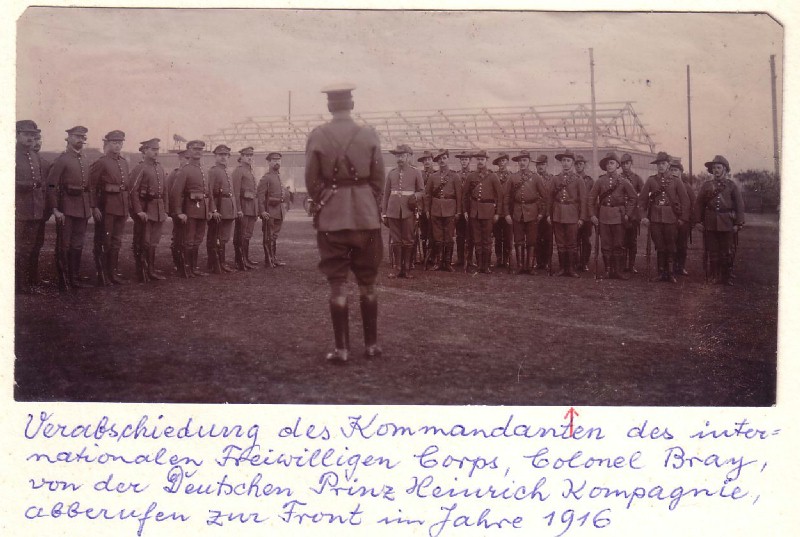
The German Prinz Heinrich Kompagnie of the SVC on
parade c1915-16
Their uniforms are the eight buttoned winter uniforms. The soldiers on the
left wear peaked field caps with German cockades above the SVC badge, while
those on the right wear the Australian slouch hat. They carry British British Lee
Metford Mk II rifles with British 1903 bandolier pouches.
The caption is roughly translated as "The
discharge of the commander of the international volunteer corps, Colonel Bray
from the German Prinz Heinrich Kompagnie, recalled to the front in the year
1916." There seems to be some confusion as to when Lieut-Col RN Bray was
called away from Shanghai for active service with his home unit.
The Straits Times of Singapore commented on 5th
April 1915 "the German and
Austrian companies specially paraded to say goodbye to Col. Bray: and
considering for what reason he is called home, the good feeling and
sportsmanship which prompted this parade will specially be remarked and must
have appealed deeply to the Commandant."
Photo © Rolf Weidlich
|